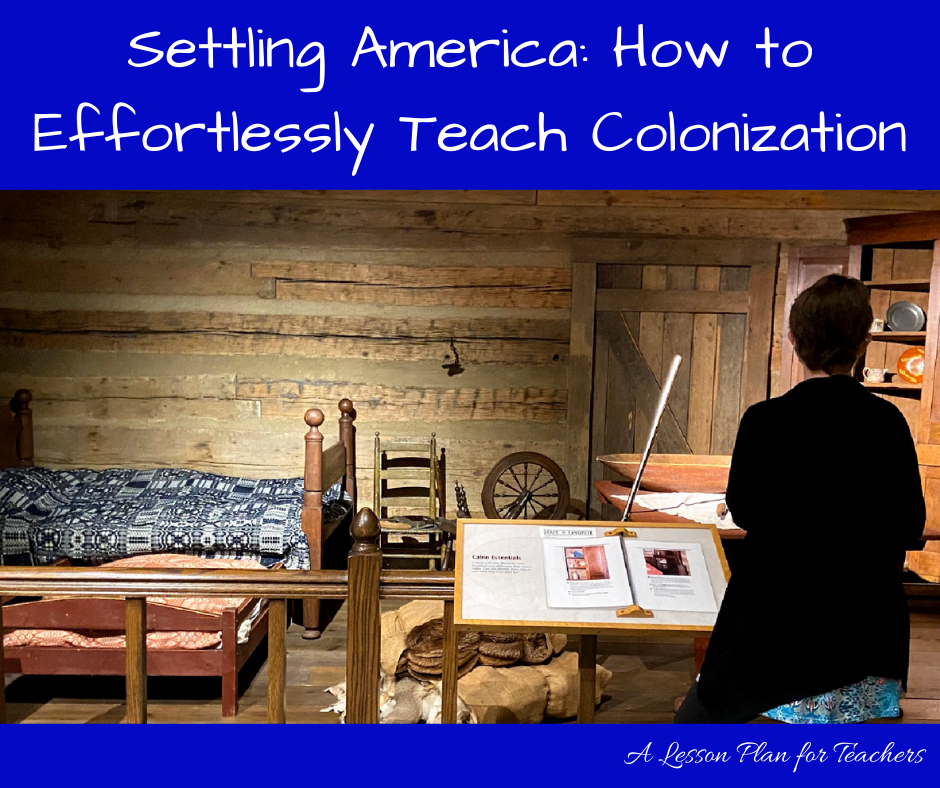When teaching the Colonization of the American Colonies, it’s important to cover the different strands of Social Studies. These include geography, culture, history, government, and economics. Comparing and contrasting between the colonies, while focusing on these areas, is an important skill to foster understanding. Using hands-on resources on Settling America helps to cement student understanding.

Teaching about Settling America through the lens of these different strands helps students to make comparisons not only to other colonies, but to their current understanding of cultures and the world. Though it is often taught as an introduction to US History, your lessons on Settling America don’t have to be rudimentary or boring. Introducing these strands early helps students to develop a strong foundation for Social Studies learning. Maintaining focus on these different strands helps students to draw parallels that make the content interesting and engaging.
Settling America: Teaching Strands for Comparison
- Geography. Focusing on geographical study of the area, students can illuminate physical features (latitude and longitude, topographical features, etc.) along with political features (like maps and borders). Also, students can examine climate and how it impacts the area. Broadly speaking, the geographic analysis will examine people, places, and the environment.
- Culture. Examining the beliefs and customs of the area, students can focus on culture by diving into arts, recreational activity, religious backgrounds, cultural traditions and food, clothing, and language. This exploration includes cultural norms of the people in the area of study.
- History. Quite basic, the study of history includes exploring the past of the area. This may include key people who founded, developed, or influenced the area, as well as how important events shaped the current culture or climate.
- Government. By studying the laws of a society, including the type of government structure, freedoms and rights, students can strive to understand how those governmental entities impact daily life.
- Economics. Studying trade, resources, and jobs helps to develop an understanding of the economics of a certain area. This study leads to in-depth understanding of wealth; currency; imports, exports, and trade; and how a society moves their money.
By introducing these strands of Social Studies early in one’s academic career, students can better absorb and retain information presented to them. These strands, while simple, are the basis of understanding and comparing. Utilizing this skillset when teaching about Settling America can help students to better understand the colonies and how similar (and different) they are from one another and today.
Teaching American Colonization as Hands-on Learning
Though you could do a basic “research and response” exercise where students look up this information and write it in their notebooks, there are many other ways to explore these strands! Activities that are way more fun and hands-on are more likely to engage students. This leads to better student retention!

These are great for younger learners or those with reading challenges. Task cards include readings so it’s easy prep! It covers all the content needed, while presenting the information in a fun and engaging way. Many questions are open-ended and thought-provoking, requiring critical thinking skills.

American Colonial Settlement Centers Activity or Archeological Dig
Perfect for getting students up and moving, this dig is aimed for middle school students. This covers all the strands with in-depth learning. Fun and engaging, this centers activity allows collaboration, critical thinking, historical thinking, comparison, and Primary Source Analysis.

Comparing the American Colonies
Designed as a response group activity, students collaborate to compare the different colonies. To do so, they utilize the strands of Social Studies for colony. Reading is chunked so it’s very adaptable for middle or high school students learning American history.

Utilizing these hands-on activities and resources when teaching about Settling America and Colonization will surely engage students on a whole new level! By fostering these skills and using these Social Studies strands early, students will engage with the content in a memorable way. Try these exercises in your classroom to ease the process of teaching about Settlement and Colonization!
Bonus! Try the Early American Settlement Primary Source Analysis & Inquiry Activity to help students develop their PSA skills.
Lastly, if you want to really dive into Primary Source Analysis, you can also download the Early American US Document Primary Source Bundled Set!
Happy Teaching!
